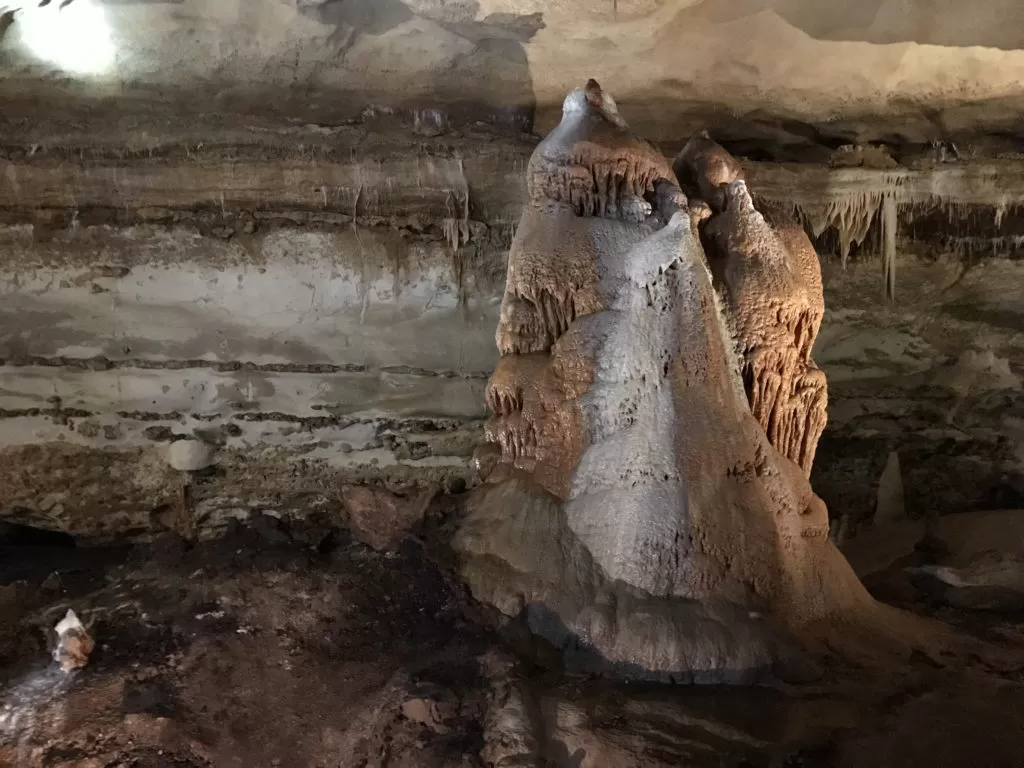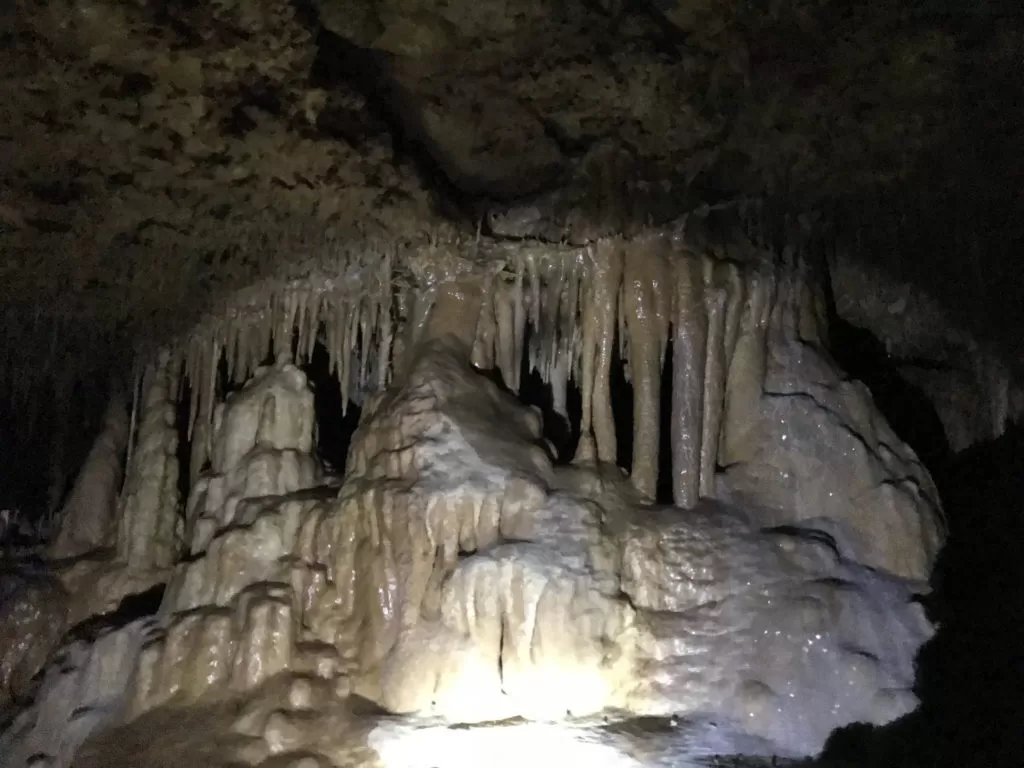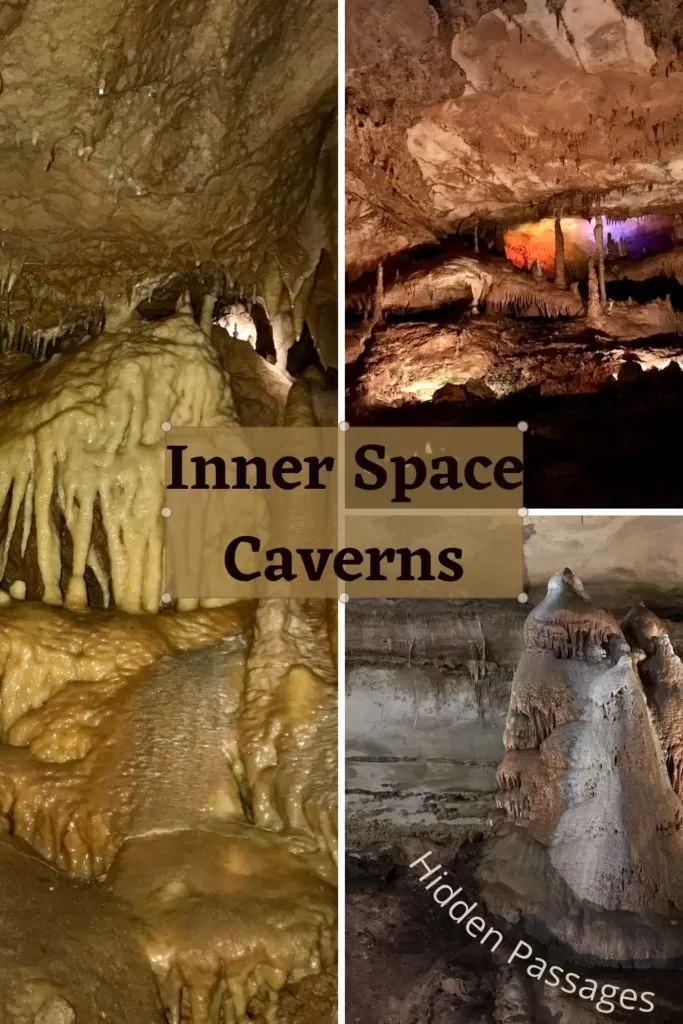During my family’s latest trip to Austin, Texas, we visited the Inner Space Caverns, among other places. Besides spending time outdoors, in both state and city parks in Austin and exploring the San Antonio Missions, we also spent one morning caving, touring the Inner Space Caverns.
With its entrance near the highway, the cave is only about 20 minutes from Austin. Hidden for over 10,000 years, it was discovered in 1963, when they were building the highway above it. Opened to the public in 1966, it offer several tours for visitors to explore it.
We opted for the Hidden Passages Tour, less popular and more challenging than the Adventure Tour. The most challenging tour they offer is for serious cave explorers, willing to be underground for four hours and crawl through narrow passages.
The Hidden Passages Tour proved to be perfect for us. In a small group, led by a retired science teacher, we walked through about a mile and a half of dark passages. Carrying our own flashlights added to the adventure.

Learning About The Cave Before Entering It
After getting our tickets, we had about a 20 minute wait til the Hidden Passages Tour started. Instead of browsing the busy gift shop, we spent that time learning about the cave.
Formation of the Inner Space Caverns
The cave of the Inner Space Caverns is a karst cave, formed sometime between 60 and 100 million years ago. Karst is the name of landscape features formed by dissolving certain types of rocks, most often limestone. Though caves are the most common karst landscapes, they are not the only ones. Sinkholes, underground streams, and some springs are also karst landscapes.
In the case of the Inner Space Caverns, they formed over millions of years by water dissolving the Edwards limestone of the area. Edwards limestone dates from the Early Cretaceous period, about 100-145 million years ago. It covers much of north, central, and south Texas, it is a 350-400 feet thick limestone mixed with some dolostone and chert.
Karst landscapes, like this cave, develop where limestone and dolostone are at or near the surface, which means the composition of the Edwards limestone is perfect for it. Limestone is composed mostly of calcite and dolostone mostly of the mineral dolomite, minerals that dissolve in water over long periods of time.
When this area was under the Permian Sea, the underwater currents slowly dissolved these minerals, creating the cave about 60 to 100 million years ago. Groundwater seeping through the layers of limestone continued and still continue the process. Which means, the cave is a living cave, still evolving today.
Prehistoric Mammals

In the Visitor Center, near a giant mammoth, an exhibit under glass offered an introduction to the paleontology of the cave.
Under glass, bones of long extinct animals tell the story of the cave long before it was discovered. Turns out, the cave is an important paleontological site. About 13,000 to 25,000 years ago, the cave system had several sinkhole entrances opened to the surface. Through these entrances now long-extinct animals entered or most likely fell into the cave.
When they started exploring the cave, paleontologists found fossils and bones of at least 44 different species, 11 of which are now extinct. Among these are the Colombian mammoth, giant ground sloth, saber-toothed cat, and an extinct pronghorn.
Paleontologists found and dated here remains of extinct mammoth, saber-toothed cat, glyptodont (a giant armadillo), besides camel, horse, ground sloth, short-faced bear, peccary, bat, and other species, some of them around 23 thousand years old.
Besides scattered bones, they found several complete skeletons of an extinct peccary,Platygonus compressus. Apparently, this species had a habit of crawling into remote passageways to die.
Bats
While waiting for the tour to begin, we also had enough time to watch a short show about bats. The 7-minute show, hosted by bat conservationist Merlin Tuttle explains facts about the bats in the cave. We found out that the bat inhabitants of the Inner Space Cavern are tricolored bats. They earned this name for the three colors of the hairs on their back.
Also known by their scientific name,Perimyotis subflavus, they are one of the smallest bat species. Fortunately for us, they are also unusually tolerant of human activity nearby.
On The Hidden Passages Tour
When it was time to start the tour, our guide, a retired science teacher, gathered the group around and explained what to expect. The tour would last an hour and a half, and take us through undeveloped, though passable, areas of the cave. Because we would walk through unlit areas, he handed out flashlights for each of us to carry.
Our small group of fewer than ten people set off through the tunnel leading underground. Walking away from the well-lit areas, we each turned our flashlights on that illuminated the areas immediately surrounding us.
The trail eventually narrowed, where we had to walk single file, at times surrounded by the cave’s walls on both sides.
Cave Formations

Cavities left and right showcased spectacular cave formations, from stalactites and stalagmites to columns of different shapes and sizes, soda straws and other odd-shaped formations, even some that look like bacon, in every direction.
Before you ask, soda straws are actually formations that look like straws, narrow, usually long, and hollow in the middle. They are also called hollow stalactites.

Stalactites grow from the ceiling – the way I remember the difference between stalactites and stalagmites is their meaning. Their name both comes from Greek; Stalactite from stalasso meaning “to drip”, and stalagmite from stalagmias, meaning “dropping, trickling”.
Stalagmites grow from the floor, due to mineral deposits from water dropping from the ceiling.
However, when water is just dripping from the cave’s ceiling, this drip is so slow that it stops and the minerals in it turn it into stalactite. Soda straws form in a similar way, though the water drips all the way through, only the sides harden, forming a hollow tube. If the hole on the bottom closes though, they can turn into stalactites.
The most unusual formation our guide pointed out was something I haven’t seen in other caves. Some of these soda straws had tiny “straws” growing from them sideways in all different directions, defying gravity. Called helictites, they are a mystery to scientists, who can only guess of how they may have been formed.
“Meeting” a Bat in the Cave

As expected, we saw several bats in the cave, one of them sleeping so close to the trail we could have touched it. We experienced first-hand that these tiny bats are indeed no bothered by humans nearby. I remember in other places, bats would wake up if we’d shine a light on them or if the kids were noisy near them.
Here, this tiny tricolored bat didn’t even move as our guide shone his light on him for all of use to see him. He didn’t mind the photos either, each member of the group stopped and took a photo of him, while he kept on sleeping. Our guide knew where to find him, too, we didn’t stumble upon him by accident.
Apparently this bat loves sleeping near the trail; he seems to enjoy people traffic while hibernating.
The Real Meaning of “Pitch Dark”
Deep inside the cave, our guide stopped, and we gathered around him. “In a minute I will ask you all to turn off your flashlights. Here, underground you will experience real dark like you can never experience above ground. Even on the darkest night, in the darkest spot on earth, you’ll still have some stars in the sky. But here, you won’t see anything at all. You won’t see your own finger if you hold dit infant of your eyes. Ready to try it?”
So, we all turned off our lights. And indeed, it was darker than I could have imagined. Darkness surrounded us from all directions. And then, before we turned on our own flashlights, our guide shone his UV light to certain areas of the cave walls, to point out the difference in the rocks. Some of them would glow in the dark after he turned his light off. He explained that these fluorescent rocks were calcite. They were all around us in the depths of the cave, mixed with the limestone.

The Hour-and-half Passed Way Too Fast
Before we knew it, before I was quite ready, the tour ended, and we were heading out into the daylight. And when we realized how crowded and noisy it got while we were underground, we were grateful that we had the opportunity to choose the Hidden Passages Tour, and go early enough to catch the first one of the day.
As I was watching the highway we would get on to take us to our next destination, I thought of it being built, almost six decades ago, and how it must have felt for the builders to discover such an extensive cave underground. As the story goes, they discovered the cave while drilling to test for safety. The drill suddenly dropped, revealing the cave beneath.
During the tour, when we were very quiet, we could hear the rumble of the highway above. Driving away, on the highway, I was thinking of the cave below.
Things To Keep In Mind When Visiting
Since the Inner Space Cavern is a living cave, the most important thing to keep in mind is not to touch any of the formations. The oil from our fingers would cause the formations to stop growing; dirt from our shoes or clothes would get embedded into the new formations.
Also, as inviting as it may seem to pet a cute sleeping bat, especially if it’s just sleeping near the trail, we should definitely not touch them either.
The cave is a comfortable 72 degrees year-round, so dress appropriately. Even more important for this tour is your footwear. Since you are exploring undeveloped areas of the cave, the trail is uneven, wet and muddy in several places, therefore slippery. So good, gripping shoes, sneakers, if possible, should be the footwear of choice.


